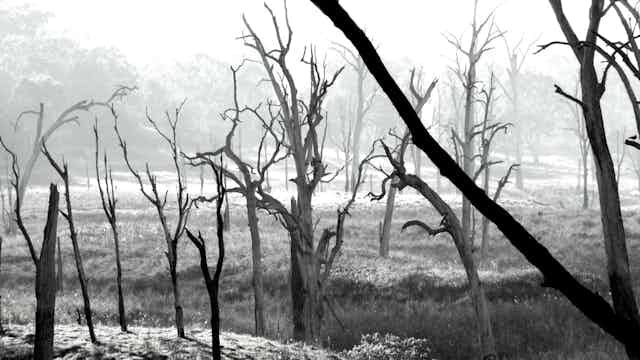Over the last 30 years, every forested continent has had a widespread drought which has killed trees. The geographical scale of drought, and the duration and almost coordinated nature of these droughts across continents, is causing extreme alarm in ecological circles.
In Australia, we had a seven-year eastern seaboard drought in the first decade of this century. Most of Western Europe was in drought in 2003: the human death toll was as high as 70,000 because of the associated heat-wave.
Crop losses and forest mortality, especially in southern Europe, were extensive; more than 500,000 ha of forest was lost in southern Europe alone. Currently the mid-west and south western United States of America are experiencing exceptional drought (a class above extreme drought), with widespread tree mortality and increased fire severity across the region.
Forests in Asia and South America have been experiencing recurrent drought, forest mortality and increased fire frequency for the past several decades.
When forests die, several things happen. Local temperatures go up; when this happens on a large enough scale it alters weather patterns. The way water catchments recharge stream-flows and groundwater is altered for many decades following the drought. The loss of forest cover across vast areas increases soil erosion through wind and, when it finally comes, rain.
Forests provide many ecosystem services: wood, crop pollination, tourism, soil stability, conservation of biodiversity and water purification. Losing vast areas of forests is detrimental to human, catchment, regional and ecosystem health.
What happens to trees during drought?
Trees exchange several hundred molecules of water for every molecule of carbon dioxide they absorb. Both these gases pass through “pores” in leaves - these are called stomata. In the absence of recurrent rain, stomata close to conserve water. This also restricts the tree’s ability to “breathe in” carbon dioxide for photosynthetic production of sugars.
During a drought, temperatures go up because of reduced cloud cover and increased sunlight, which raises ground temperature. And all the sunlight absorbed by vegetation which would normally be used to evaporate water (thereby cooling the canopy) is not used for that purpose.
Many species of trees close their stomata to conserve water, and their surface is dry, so instead the canopy gets hot and re-radiates the energy as heat, further increasing air temperature.
This increase in temperature, occurring at the same time as drought, has been identified over the past two decades as a primary cause of “global-change-type forest mortality”. Both field assessments and experimental studies have identified warmer temperatures concurrent with drought as a primary cause of forest mortality.
When the air is dry, the trees snap
If you have a drought and increased temperature, you will see a drop in air humidity. When drought occurs, soils dry out and vegetation stops transpiring: plants no longer take in carbon dioxide and “breathe out” water. Less water is moving into the atmosphere and this alone can reduced atmospheric humidity.
And as air temperature goes up, the amount of water that can be held at saturation (100 % humidity) increases and the rate of this increase gets faster and faster as temperatures rise. However, as already noted, the transfer of water vapour to the air is dropping, so the relative humidity declines with each degree increase in air temperature.
This matters a lot. The stomata of trees typically show one of two types of behaviour when water in the soil dries up: they are either isohydric, or anisohydric. For isohydric species, stomata close early in the drought to conserve water and maintain a hydrated canopy. When this persists for months, the plant exhausts its carbon reserves and dies.
For anisohydric species, stomata remain open far into the drought and the tree keeps building carbon stores. But tensions within the sapwood (the water-conducting tissue of trees) increase so much that the water columns snap and the tree suffers an embolism. The tree can repair embolisms, but when they start happening faster than the tree can fix them, the canopy loses leaves and branches and eventually the tree dies.
These reactions are in response to low levels of water in soil. But stomata also respond to the amount of water in the atmosphere. Dry air reduces stomatal opening but also increases the tensions on the water column in sapwood, just the same as dry soil does. So reduced humidity matters to forests. But which is more important – temperature or humidity?
A recent detailed modelling study of an Australian woodland (published in Ecology and Evolution in June 2013 by Eamus and co-workers conclusively demonstrated that increased aridity of the air, during drought, was more important than increased temperature, in explaining the loss of photosynthetic carbon gain.
This has important ramifications for predictions of how forests will cope with future conditions. If we don’t explicitly consider atmospheric aridity it will be difficult to design the experiments we need to predict how landscapes will behave in future. We won’t know whether forests will still be able to provide the ecosystem services humanity relies on.
There’s very little we can do about this loss of trees in the near-term. But in the longer-term, changing the way we manage the land could help. In particular, because drought increases tree mortality, this increases the dry fuel load accumulated in a forest. Increasing the frequency and extent of hazard reduction, or fuel-reduction burns will decrease the intensity (severity) and extent of forest fires.
For Australia, at least, where ecology is tightly linked to fire, this may prove beneficial both to humans and the ecology of Australian woodlands and forests.

